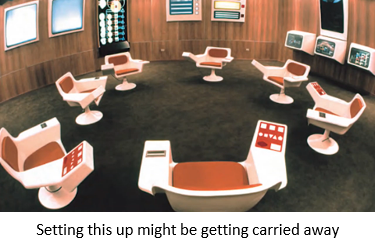Utilisation Obsession – why your organisation is in permanently clogged chaos
If you’d prefer to watch on video than read, click here!
A state of overload and chaos has become sadly normal in organisations. Here’s the thing – it comes from a very natural condition – an obsession with utilisation. I’ll explain…
These ideas originated from one of the all-time gurus – Eli Goldratt.

Way Basic Work System
To demonstrate, I’ll draw my favourite diagram that my long-time clients will recognise (with one change):

This shows a piece of work that needs to go through three areas in order (this might be something emailed around to different people, don’t think this only applies to manufacturing). The three areas are A, B and C, and the numbers shows how much that area can produce per period (which can be per day, week, month, whatever it is).
See how the total the system can produce per period is five because that’s the speed that A and B can work at? It doesn’t matter that C can produce 15.
Slightly Less Basic Work System
Now, lets get slightly closer to real and introduce more people:

Joining our party is D and E, and they also need B to do something. Do the quick maths, and you’ll see the load now coming into B is 14. But…nothing magical has changed for B, so B can still only produce at 5.
And, because of the amount of pressure now building up for B (which looks like email or workflow build up in knowledge jobs), it’s not possible to produce at the top level, so five is in fact a pipe dream.
Let alone all the hassling B will now be getting from either D, E or A asking “where’s my thing”. Or C saying “where is that, send it through?”
So all that flows through to C at best is five units per period, it will actually be less than that, so production of the whole system has decreased.
Why does this happen? Because of our obsession with utilisation!
Obsession With Utilisation
Obsession with utilisation is about that feeling that we always need to be producing. More and more. To be valuable. To survive.
Think of a typical KPI or measure for each area. Whatever fancy words are used, there’s something that says “produce a lot”. If we use basic utilisation, and set utilisation at each for 100%, the situation of clogged chaos described just above is inevitable.
It’s not just KPIs that cause this. It feels better to be productive. We feel guilty sitting around doing nothing. And if we are talking about an actual piece of equipment, one that we’ve invested $3 million into – then we want to see that thing producing!
The only area that needs to be producing at 100% is B! For anyone else to do this….just slows down the whole show. And here’s the thing – each area or person in the system will genuinely believe they’re doing a great job!
So, we are doomed by the combination of how we design the system itself and human nature to be useful into a situation of permanently clogged chaos. Unless…
What To Do?
Here’s three things:
1. Talk about this. Draw the A B C diagram, discuss which area or person might be ‘B’, and have a conversation about the pressures that see everyone needing to keep on producing even when nothing can go any quicker.
2. Makes sure the goal of the system is clear. That number in the circle on my little diagram – whatever your version of this is. That goal needs to sit above any individual goal, so if it’s not clear in the first place, you’re starting from behind the 8-ball.
3. Set up the tangibles. By ‘tangibles’ I mean the way work itself is managed. These divide into group tangibles and individual.
For group, make sure the team has a way to visualise their work. This consists of being able to see all initiatives at the same time, as well as the operational measures that give the feedback loops for improvement. This allows the full system to be seen at once, which is the foundation for conversations that start improving the whole show by identifying which area sets the pace, helping them, and perhaps redesigning the system.

For individual, it’s about making sure that the KPIs themselves don’t encourage actions that only help the individual. The production of the whole system must be one of the factors considered, with individuals getting feedback on the value of their contribution to the whole system.
In other words, no prizes for jumping the line if it doesn’t help everyone in it!
Bringing It Home
Do the above, and you are creating a situation where all the actors in the system are incentivised to have conversations about how to improve the whole thing. Individual utilisation is only useful for that area ‘B’ that sets the pace of the whole show. For everyone else, it’s just making themselves look good.
Make sure your show is set up so looking good only happens when the whole system does by breaking the obsession with utilisation.
Unless you change this, you can do all the kumbaya in the world, but you’ll still end up back in clogged chaos.
